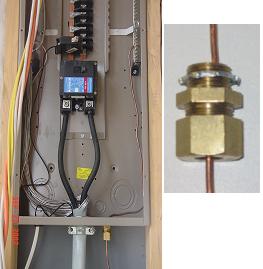mijoni
Member
- Location
- Central CT
First off let me say hi to everyone. I'm an electrical apprentice working in the northeast us doing primarily residential work and some light commercial.
I have a question I'd like to ask that would help alleviate some doubts I have regarding proper bonding methods of feeder-supplied panels (subpanels) in residential situations, strictly single-phase 240/120v.
Our company has installed lots of resi subpanels in varying situations such as attached structures, remote etc., and if they are new subpanels, they are always fed via a 4-wire feeder regardless of their location. My boss prefers GE products and that is what we use 99% of the time. SOP for our GE subpanels is to pull a 4-wire feeder, remove the strap between the right and left neutral/ground buses and use one side solely for landing neutrals, the other for landing grounds.
My question is rather simple, and your input would help end an ongoing "peeve" I've had with the boss since the very first GE residential subpanel we did.
Can the green bonding screw that is supplied with GE panels be safely used to bond the panel case to the (separated) ground bus? Or should another method be used? He says "no", do not bond -either- bus in any fashion to the panel case. I feel this is wrong because on the GE panels we use, the ground/neutral buses sit in an insulated plastic retainer which does not have any electrical connection to the case itself.
My opinion (correct me if I'm wrong, that's what I'm here asking for) is that since the green bonding screw is rated for use to bond a neutral to the case, why not use it for the ground bus in a subpanel? Keep in mind the ground/neutral buses would be separated, and the green bonding screw would only be installed on the ground bus.
So far no inspector has said anything, and I'm not about to initiate a conversation with one regarding this
Thank you and highest regards to all.
I have a question I'd like to ask that would help alleviate some doubts I have regarding proper bonding methods of feeder-supplied panels (subpanels) in residential situations, strictly single-phase 240/120v.
Our company has installed lots of resi subpanels in varying situations such as attached structures, remote etc., and if they are new subpanels, they are always fed via a 4-wire feeder regardless of their location. My boss prefers GE products and that is what we use 99% of the time. SOP for our GE subpanels is to pull a 4-wire feeder, remove the strap between the right and left neutral/ground buses and use one side solely for landing neutrals, the other for landing grounds.
My question is rather simple, and your input would help end an ongoing "peeve" I've had with the boss since the very first GE residential subpanel we did.
Can the green bonding screw that is supplied with GE panels be safely used to bond the panel case to the (separated) ground bus? Or should another method be used? He says "no", do not bond -either- bus in any fashion to the panel case. I feel this is wrong because on the GE panels we use, the ground/neutral buses sit in an insulated plastic retainer which does not have any electrical connection to the case itself.
My opinion (correct me if I'm wrong, that's what I'm here asking for) is that since the green bonding screw is rated for use to bond a neutral to the case, why not use it for the ground bus in a subpanel? Keep in mind the ground/neutral buses would be separated, and the green bonding screw would only be installed on the ground bus.
So far no inspector has said anything, and I'm not about to initiate a conversation with one regarding this
Thank you and highest regards to all.



